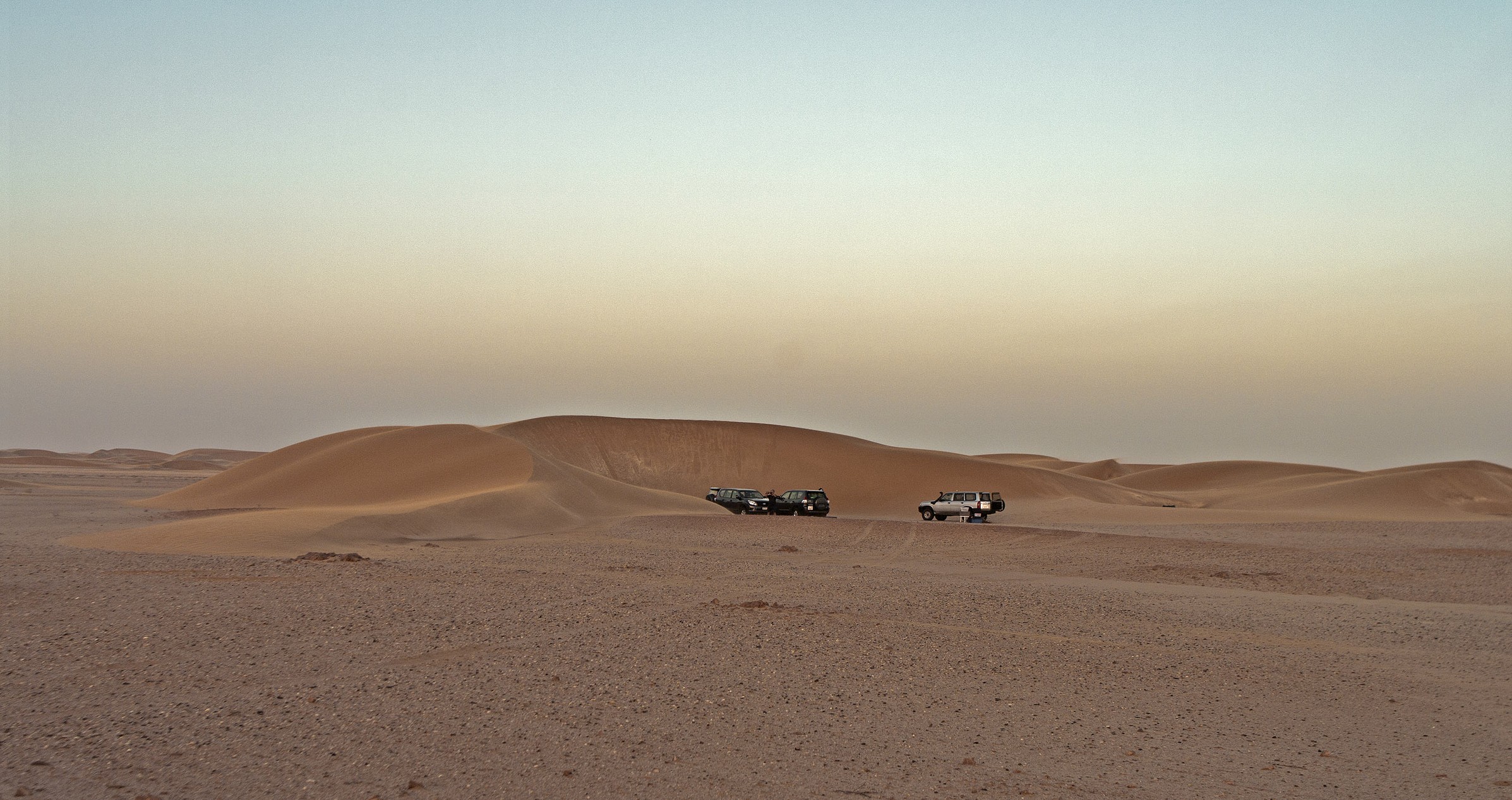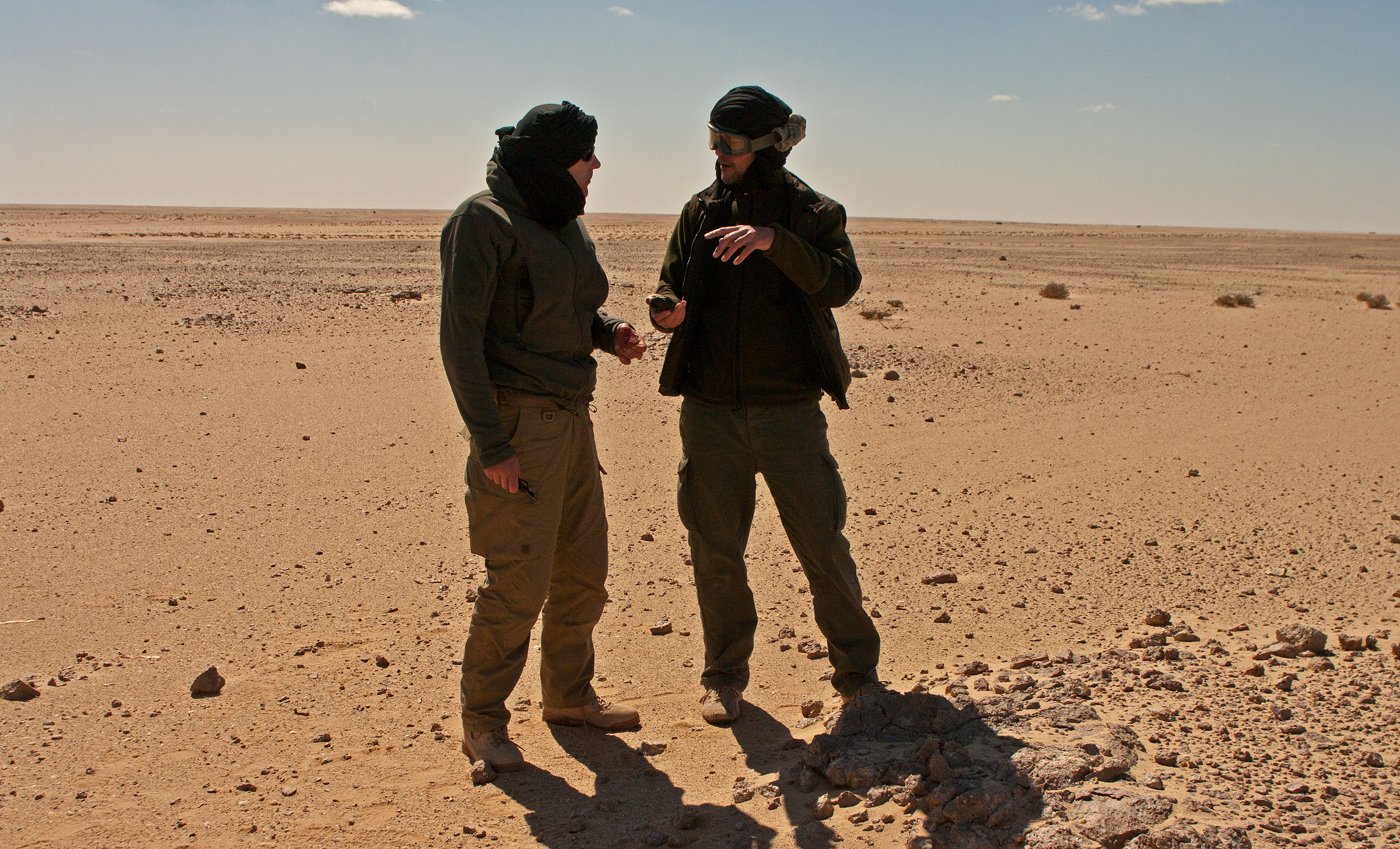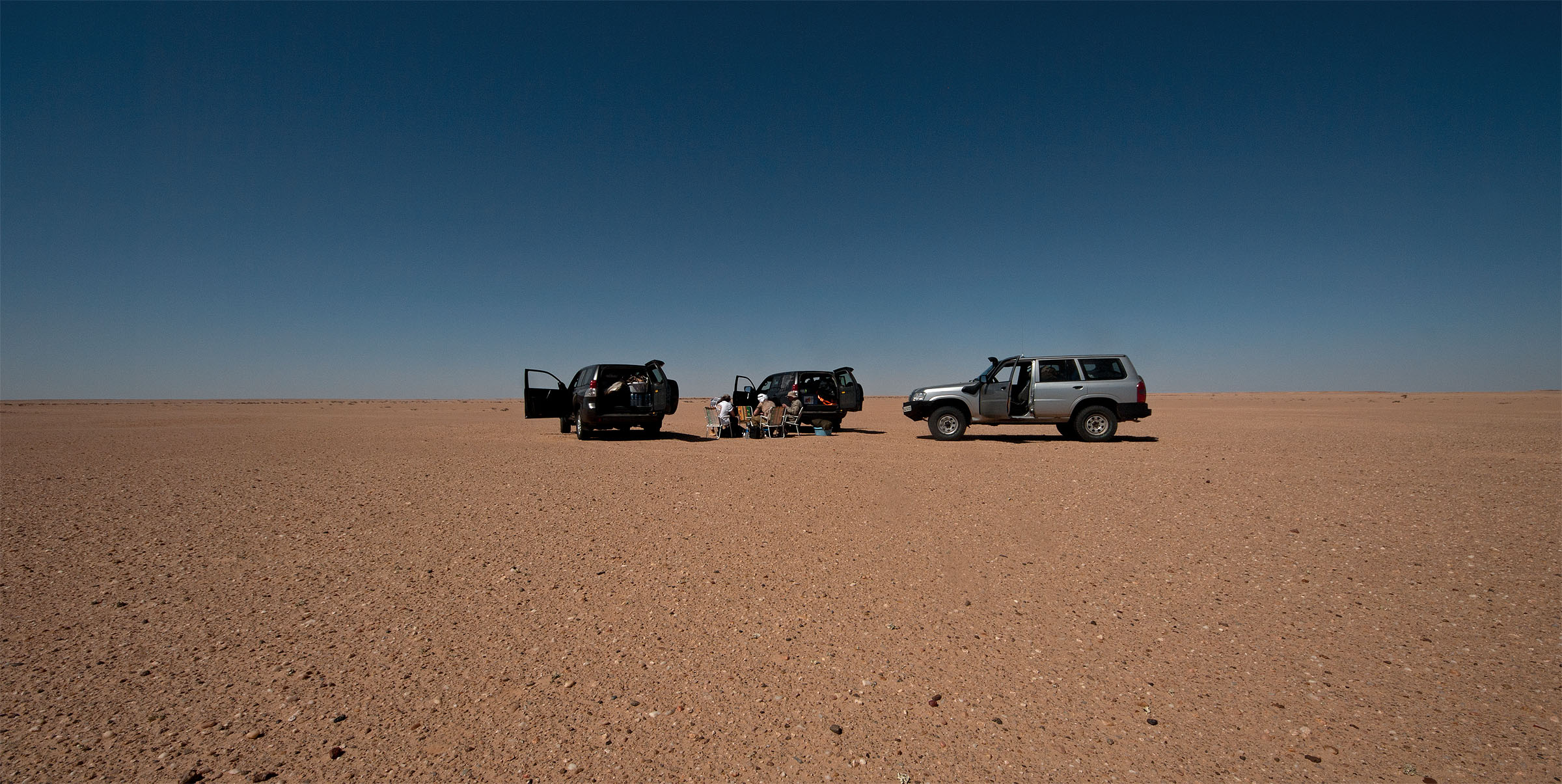When the three cars fanned out and progressed into the featureless void, I felt a great relief. Apart from minor misfortunes, such as Andi’s acid-punctured pants, everything during our 800 mile journey had worked out as planned so far. Not even a damaged tire. Knock on wood. But this was not easy territory. Three weeks of field time now lay ahead of us. Out in the Reg Al Mhoum, some 120 miles from the coastal road and the next settlement, one had to be aware of the fact that the desert alone made the rules – and little did it care about plans made at the green table.
The topography was flat with few shallow dry river beds, or queds, as they were called in local Berber, in between. One geomorphologic peculiarity of the area was the abundance of large sedimentary pans enclosed by the escarpments of the higher plateaus that surrounded them. These flat-bottomed basins were endorheic karst depressions with subterranean drainage systems, formed by the extensive hydrological activity in the late Tertiary and early Pleistocene.
Today these basins were filled by thick alluvial and aeolian sediments, their top surface usually covered with fech fech, a quicksand-like powdery silt that is produced by the disintegrating clay and limestone. To the great dismay of the desert traveller, the fech fech is commonly hidden under a thin hardened crust that collapses under the weight of a vehicle, which often ends in getting the car hopelessly stuck.
The geological term for these endorheic basins is polje, in the local Berber dialect they are called graret, grart or gart, the most famous and one of the largest being the Quatarra Depression covering an area of 75 x 50 miles in the northwest of the Libyan Desert. Here, in the central part of the Moroccan Western Sahara, the grarts were much smaller. And although the valley floors were often 30 or 40 meters lower than the encircling cliffs, they rarely reach diameters more than a few kilometers.
Geologically, our search area belonged to the onshore portion of the Aaiun Basin that extends for about 680 miles from the Cap Blanc Fracture Zone in northern Mauritania north through southern Morocco to the intersection of the North Canary Island Fracture Zone and the South Atlas Fault.
In the east, some 170 miles from the Atlantic coast, it is separated from the older Tindouf Basin by a swell in the northern extension of the Precambrian Reguibat Massif and Palaeozoic fold belt of the Mauritanides. The Aaiun Basin comprises Mesozoic and Cenozoic continental and shallow marine sediments overlying a basement of Precambrian and Palaeozoic age.
The surfaces we were dealing with were Cretaceous, Tertiary and Quaternary sediments deposited in the Aaiun Basin, with the top horizons consisting of Pleistocene pediments composed of weathered limestone fragments and quartzite pebbles mixed with cherts, silcretes, sandstones, shales and dolomitic carbonates, often overlying a fine-grained silt. The varying textures, colours and respective degree of desert varnish on the surface accounted for a chaotic pattern that made the visual identification of meteorites challenging.
Because the general topography followed the north-to-south orientation of the Aaiun Basin, moving transversely to the orientation of the elevation profile, as we did, brought successive changes of the surface pattern with it. Thus, travelling west-to-east required re-adjusting to different types of background rocks every ten or fifteen kilometers. One half of the team was already used to these difficult search grounds from the previous trip to the Hammadas, north and south of the Saquia al Hamra. There, two years ago on occasion of our first expedition in the area, we had proven that even on surfaces offering little-to-no background contrast to the commonly dark brown or black meteorites, finds could be made, albeit only after a lot of time and effort.
Andi and I stopped frequently in order to pick up dark rocks and get acquainted with the local pediment surface and the meteorwrongs among it. It would take us another few days until a casual glance from the corner of the eye would be sufficient to recognize the black chert gravel as such and exclude them as targets. Many more hours of searching would be necessary to develop the unerring security in our assessment that was necessary to pick out one promising target among tens of thousands of rocks passing by in an average search hour.
Given their vast experience from meteorite prospecting in other deserts, I trusted that the others would quickly adapt to the difficult search grounds. In particular Rainer was a skilled mineralogist and seasoned field expert, and we were glad to have him with us since his judgements could be utterly trusted.
Shop talk: S. Buhl, A. Koppelt
Two hours later, when the sun almost touched the horizon, even the smallest pebbles casted long shadows. Searching had by then become pointless. We had made only slow progress and were still 12 miles from point Bravo, the site of our night camp. I stopped at a dry acacia to gather some dead branches for the fire and to wait for the others.
When Rainer’s Toyota appeared from behind a shallow hill, I waved him over and, after briefly discussing the situation, we agreed to make a dash for the campsite in order to get there before darkness. I had suggested the Bravo location for its wind-protected topography, but my only knowledge of the place was taken from a Landsat image. Getting a view of the site during daylight would sure be helpful, particularly as it was located within a depression that was bordered by cliffs, cut by deep queds and crossed by extensive sand fields.
It appeared that Marc and Sergey hadn’t taken the message to stay in sight very seriously. At least they were nowhere to be seen. ‘We’ll continue”, I decided, and hoped they had taken better care in writing down the coordinates of our rendezvous point.
Not fully trusting the ground ahead of us, I first accelerated with caution but soon found that on the flat terrain 50 mph was a manageable speed. Whistling ‘It’s a long way to Tipperary’ and trailed by a mounting cloud of red dust we headed for the campsite. Well, it may go on like this, I mused.
The shallow bump that had been invisible in the pattern of long shadows until the last second left no time for a warning. ‘Get a grip!” I shouted to Andi, who was daydreaming out the side window, but the Toyota was already airborne. The heavy car took the impact surprisingly well. Not so with Andi’s head, which audibly made contact with the car roof. Still dazed, he shot me an accusing look: ‘Next time you pull such a stunt I want to know in advance” he demanded. Obviously I had neglected to brief him on the duties of a vigilant co-driver. ‘Buddy, as the navigator it’s in your responsibility to announce the obstacles” I gently explained. However, keeping the vehicle on track in the bottomless sand field that had suddenly appeared out of nowhere required my full concentration, and I was too busy to follow the matter any further. And no more complaints were issued. Instead, for the remaining twenty minutes of the drive my mate fiercely clung to the roof handle in white-knuckled anticipation of the next jump, his full attention dedicated to the terrain ahead of us.
Soon the nameless outlier mountain that marked tonight’s campsite came into sight. It rose from the bottom of the Gart Aouirtefu, a large trough-shaped karst basin with a length of four miles and a width of two miles, eroded from the surrounding plateau of Zamlat Swid.
The inselberg’s flat top was level with the plateau’s surface, from which it had become separated during the Late Tertiary/ Early Pleistocene wet phases until about 2.3 million years ago, when the shaping of the basic landforms in the Sahara occurred. During later wet phases, such as the Abassia Pluvial between about 133 and 122 thousand years ago and the Holocene wet phases between 12.5 and five thousand years ago, the Aouirtefu Basin had hosted temporary lakes and swamps the traces of which are still present in the shape of cemented lake sediments, their remnants lining the edges of the valley. Since these times the inselberg had towered over the valley like a capped pillar.
Because the sedimentary filling of the valley continued to the present time, its rather recent surface was highly unsuitable for any meteorite prospection. The surface of the surrounding plateaus, however, hadn’t changed much during the last 20 to 30 thousand years. Even if the high grounds had developed a soil cover during more humid phases, due to the deflation processes that began about 5,000 years ago, any meteorites that had been embedded within these soil layers were now resting on the surface again, unless somebody had already picked them up, of course.
The ground became more uneven now, and over rocky terraces and gravel slopes we descended into the southwestern end of the Aouirtefu by crossing a network of steep gullies. Meanwhile, Marc and Sergey had caught up with us, and our rearranged convoy slowly zigzagged around the gravel banks and low sand drifts. With the last light we reached the campsite in a small canyon carved in the western escarpment of the valley. We had arrived in the desert.
In the field again, Bir Aridal area, February 2012
Stepping out of the car I was greeted by an icy wind. The temperature had dropped considerably. Marc came over, all smiling, already donning a heavy wool sweater: ‘Welcome to warm and sunny Sahara! Let’s make a fire before we all freeze solid’, he suggested.
I grabbed my leather jacket, which I had packed in a lucid moment, and began to clear a patch of even surface from stones before I pitched my tent and then Marc’s, who was already busy unpacking the kitchen utensils and firing up the gas cooker. Sergey carried an armful of firewood to a wind-protected corner where Andi had started to build a fireplace. Everybody was working silently setting up the camp.
Only Thomas stood on a rock, wrapped in at least two sweaters and a heavy jacket, a wool cap over his head, hands on his hips and staring into the blowing dust that whirled in the beam of my flashlight. ‘What’s wrong buddy?” I asked. Grim-faced he played the dissatisfied package tourist: ‘I booked full board in the Sahara, not the Arctic. Where is my luxury suite? Where is the tour manager? I want to complain!’
‘Well’, I replied, ‘then I guess you missed the small print in the travel contract. By virtue of his office, the tour manager just assigned you for kitchen duty. Now move your lazy butt up there and get those onions chopped’, I announced, throwing him a box of vegetables. ‘Yes sir!’ he saluted and off he went. If I hadn’t known Thomas, I’d probably have been seriously concerned.
After an excellent dinner that the chef de la cuisine Marc Jost had skillfully prepared, we huddled close by the fire and uncorked another bottle of red Guerrouane. It was indeed chilly. The thermometer had dropped to 40°F and the wind blowing thick gusts of dust in our faces did not help making things more comfortable. Despite the adverse conditions, toasts were proposed and old desert adventures shared. Spirits were excellent.
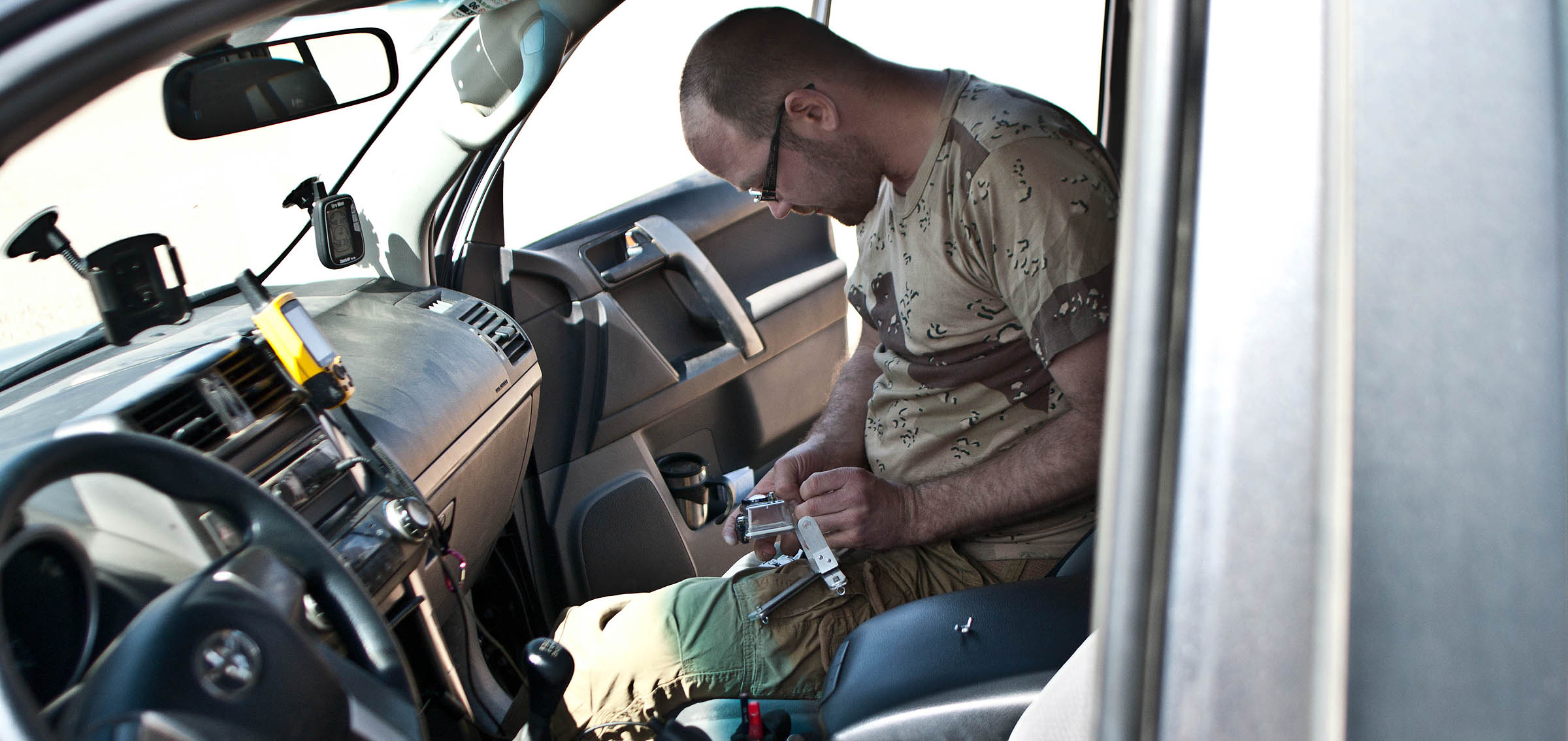
T. Fuellengraben, mechatronic in charge
Due to the strong wind, the small pile of firewood was dwindling quickly and after another hour it was all gone. Since there were no sources of combustibles in the closer vicinity, our party ended before it had really started – much to everyone’s regret . Because there weren’t any alternative entertainment offerings in the cold and dark Western Sahara night other then sleep, soon everybody went into their tents.
One learns by experience, and this case was no exception. From the following day on, firewood was on everybody’s mind. Each of us kept his eyes open and scanned the ground for firewood, night and day. Every tiny bit of wood, be it a single windblown acacia twig, a lone tent pole that stuck in the sand, the brittle handle of a lost hammer or an old ammo crate, its remains scattered across the plain – every burnable object was picked up and secured to the cars. This way every evening huge bundles of wood were dumped near the fireplace, and often the supply even served for the following day.
One evening, Marc dragged a meter-long trunk of an acacia behind his Patrol. ‘It lay in the desert …, must have fallen from a nomad’s truck’, he shrugged to our inquisitive looks. I did not notice how deeply the quest for firewood had rooted itself in our collective subconscious until our return to civilization, when Marc suddenly hit the breaks in front of our hotel in Agadir because he had spotted a plank at the roadside. Anyway, after that first night, never again during the whole trip we experienced a lack of firewood.
When I woke up, it was still dark. Condensed water dripping from the tent walls had soaked my sleeping bag wet to the core. Of course I hadn’t brought a waterproof shell. After all, I had packed for the desert, not the Arctic, as Thomas had put it.
Besides, the annual temperature curve for Dakhla had given maximum lows for February of 57°F with a relative humidity of around 50 percent. Instead we had temperatures around freezing point and a humidity exceeding 90 percent. I simply had not considered that the northern trade winds passed a considerable distance along the Atlantic coast before they reached the projecting mainland of the Western Sahara. Usually a steady guarantor for dry continental weather, the effect of the Sahara trade winds in this corner of the desert was a surprise to me.
Andi and Sergey were already up and they greeted me with a steaming cup of coffee. Wrapped in their parkas, the two were silently watching the eastern horizon where the first dull light crept through the early morning mist. Soon the fog disappeared, and the surroundings of our campsite emerged from the twilight. Behind the escarpment bordering the opposite side of the qued, the quicksilver disc of the sun appeared. To our back, up on top of the bank towering our camp, the outlines of two prehistoric grave mounds overlooking the broad valley from the edge of the plateau became visible. In this ancient amphitheatre, we took in the peaceful scenery before us that utterly compensated for the discomfort of the night.
‘Up for a morning walk to those cairns?” I asked Andi, pointing my cup towards the ancient mounds uphill. ‘Two minds, one thought” he smiled, and grabbed his camera. At the top of the cliff the bare dolomite rock was coated with millennia-old desert varnish. A lime green carpet of small curled plants covered the darkened rocks on the plateau. On inspection I recognized the familiar frucitose lichen Ramalina maciformis. The pre-Islamic graves were of the standard circular-type stone cairn, the most common structure of the proto-Berber tumuli in the Central and Western Sahara. In their original state they may have reached breast height, but now they were about half this high and perhaps five to eight yards in diameter.
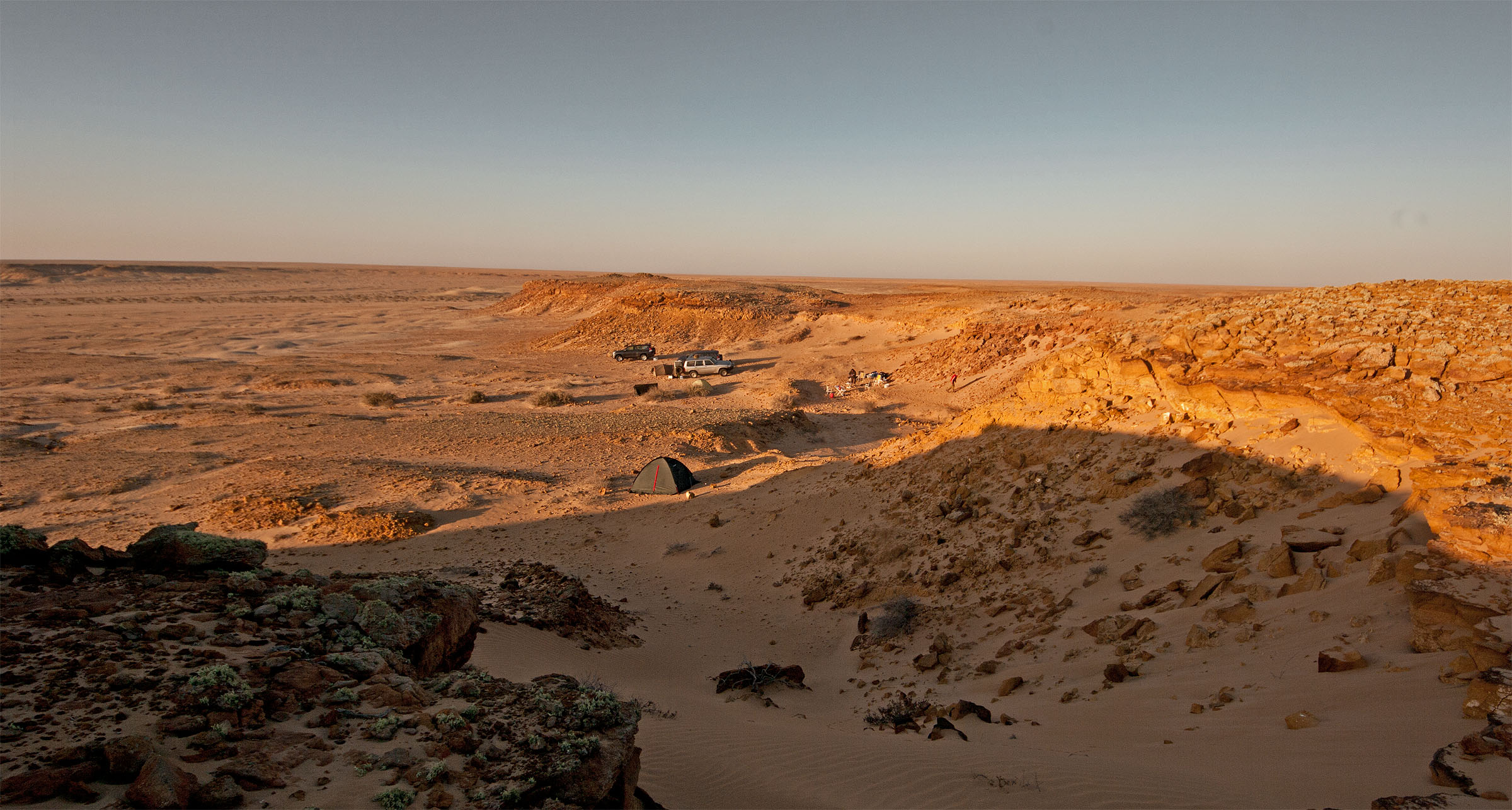
Sunrise at our 1st camp, eastern edge of the Gart Aouirtefou
In this part of the desert, prehistoric burial sites were rather common. The mounds are usually found on the crests of ravines or at the borders of plateaus and are commonly associated with temporary settlements nearby.
This site was no exception. After five minutes I found the first signs of human presence in the shape of small potsherds. The fragments were strewn over several meters and belonged to a pot of the dotted wavy line type. In northern Africa, linear pottery is characteristic of the postglacial Neolithic and the dotted wavy line decoration pointed to a rather early type. Similar pottery has been found across the Sahara-Sahel belt and had been dated from the eighth to the fourth millennia BC.
Despite the exposed find situation on the surface, the potsherds were well preserved and one could still see how the pattern was applied into the soft clay with a comb or a shaped piece of wood by the skillful Neolithic craftsman.
We photographed the site and speculated about the conditions at the time when the tumuli were erected. For our search area in southern Morocco and the western fringes of the Sahara, scientists believe that today’s hyper-arid conditions are similar to what was in place at the end of the last glacial maximum, some 24-15 ka ago.
At that time, the large northeast to southwest oriented dune systems accumulated across most of the central Sahara. By about 12,500 – 9,500 years ago, however, more humid climatic conditions prevailed that lasted until about four to five thousand years ago. During this first Holocene wet phase, savannah vegetation stretched from the coast of the Atlantic Ocean as far north as Tan Tan, over the great massifs of the Tassili, the Acacus and the Ennedi, across the Uweinat to the Nile Valley. Elephants, giraffes and ostriches roamed the valley below us, olive and pine trees cast their shadows on the two grave mounds at their feet.



